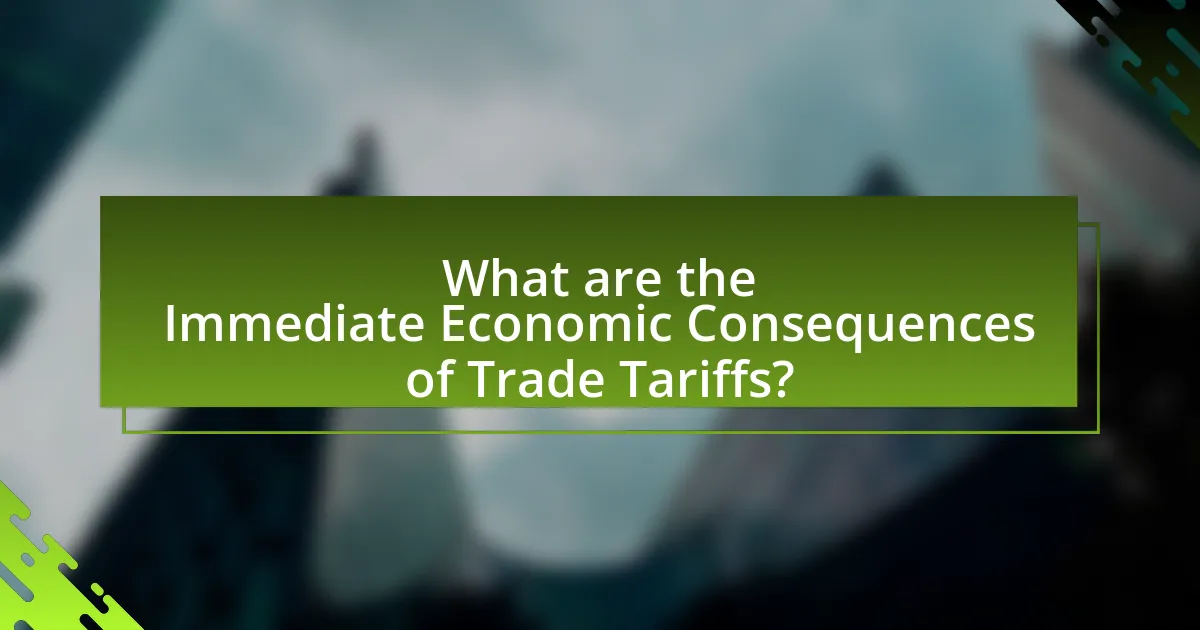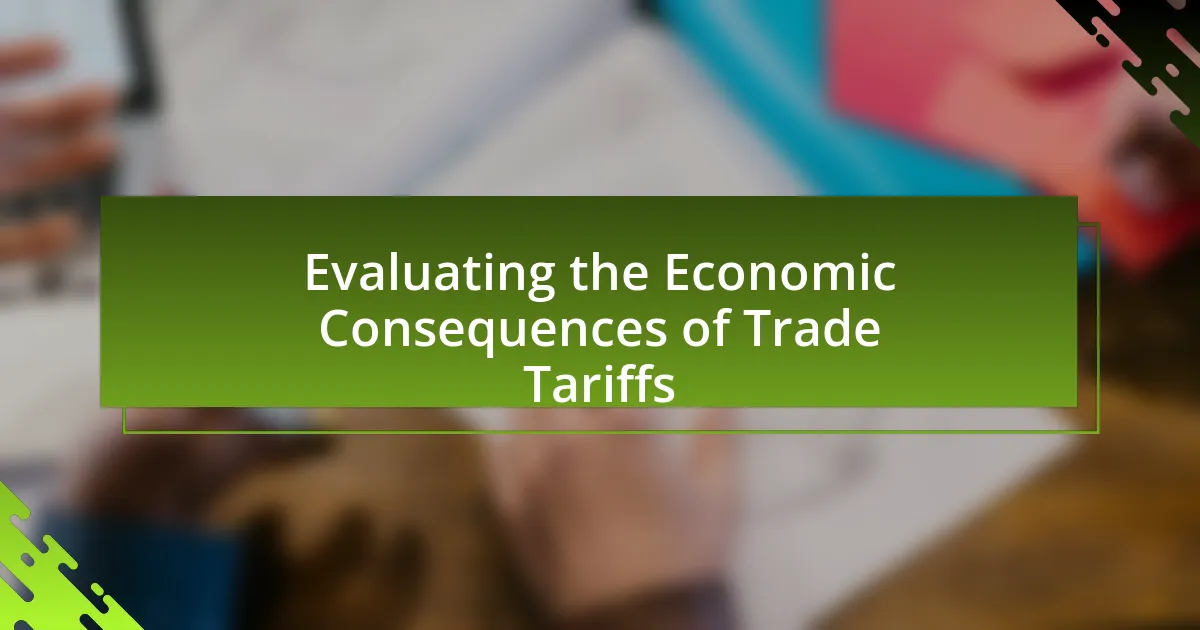Trade tariffs are taxes levied by governments on imported goods, aimed at protecting domestic industries and influencing international trade dynamics. This article evaluates the economic consequences of trade tariffs, detailing their purpose, types, and effects on consumer prices, domestic producers, and international relations. It explores how tariffs can lead to increased prices for consumers, reduced economic growth, and potential trade wars, while also examining strategies businesses can adopt to mitigate their impact. The analysis highlights the broader implications of tariffs on global supply chains and foreign investment, providing a comprehensive understanding of their role in the economy.

What are Trade Tariffs and Their Purpose?
Trade tariffs are taxes imposed by a government on imported goods, designed to increase the cost of foreign products and protect domestic industries. The primary purpose of trade tariffs is to encourage consumers to buy locally produced goods by making imports more expensive, thereby supporting local businesses and jobs. For instance, the United States has historically used tariffs, such as those on steel and aluminum, to safeguard its manufacturing sector from foreign competition. These tariffs can also generate revenue for the government and serve as a tool for negotiating trade agreements.
How do trade tariffs function in the global economy?
Trade tariffs function as taxes imposed by governments on imported goods, influencing international trade dynamics. By increasing the cost of foreign products, tariffs aim to protect domestic industries from foreign competition, thereby encouraging consumers to purchase locally produced goods. For instance, the United States imposed tariffs on steel and aluminum imports in 2018, which led to a rise in domestic production but also resulted in retaliatory tariffs from other countries, affecting various sectors. This illustrates how tariffs can create a ripple effect in the global economy, impacting trade balances, consumer prices, and international relations.
What are the different types of trade tariffs?
The different types of trade tariffs include ad valorem tariffs, specific tariffs, and compound tariffs. Ad valorem tariffs are calculated as a percentage of the value of the imported goods, making them variable based on the price of the product. Specific tariffs are fixed fees based on the quantity or weight of the goods, providing a consistent cost regardless of the item’s value. Compound tariffs combine both ad valorem and specific tariffs, applying a percentage of the value along with a fixed amount per unit. These classifications are essential for understanding how tariffs impact international trade and economic policies.
How do tariffs impact international trade relationships?
Tariffs significantly impact international trade relationships by altering the cost dynamics of imported goods, which can lead to reduced trade volumes between countries. When a country imposes tariffs, it raises the price of foreign products, making them less competitive compared to domestic goods. This can result in retaliatory tariffs from affected countries, escalating trade tensions and potentially leading to trade wars. For instance, the U.S.-China trade conflict saw tariffs imposed on billions of dollars’ worth of goods, which disrupted established supply chains and reduced bilateral trade by approximately 20% in 2019. Such actions can strain diplomatic relations and hinder cooperation on other global issues, illustrating how tariffs can reshape the landscape of international trade.
Why are trade tariffs implemented by governments?
Trade tariffs are implemented by governments primarily to protect domestic industries from foreign competition. By imposing tariffs, governments increase the cost of imported goods, making them less attractive to consumers compared to locally produced products. This strategy aims to support local businesses, preserve jobs, and enhance national economic stability. Historical examples include the Smoot-Hawley Tariff Act of 1930, which raised tariffs on numerous imports in an effort to protect American industries during the Great Depression, illustrating how tariffs can be used as a tool for economic protectionism.
What economic conditions lead to the imposition of tariffs?
Economic conditions that lead to the imposition of tariffs include trade imbalances, protection of domestic industries, and national security concerns. Trade imbalances occur when a country imports significantly more than it exports, prompting governments to impose tariffs to protect local businesses and reduce the trade deficit. For instance, the United States has implemented tariffs on steel and aluminum imports to support its domestic manufacturing sector, citing the need to protect jobs and industries from foreign competition. Additionally, tariffs may be imposed to safeguard national security, as seen in the restrictions on technology imports from certain countries to prevent potential threats. These economic conditions create a rationale for governments to utilize tariffs as a tool for economic policy.
How do tariffs protect domestic industries?
Tariffs protect domestic industries by imposing taxes on imported goods, making them more expensive compared to locally produced products. This price increase encourages consumers to purchase domestic goods, thereby boosting local production and preserving jobs within those industries. For example, the U.S. steel tariffs implemented in 2018 led to a significant increase in domestic steel production, as companies faced less competition from cheaper foreign imports. This demonstrates how tariffs can effectively shield domestic industries from international competition, fostering economic growth and stability in specific sectors.

What are the Immediate Economic Consequences of Trade Tariffs?
The immediate economic consequences of trade tariffs include increased prices for imported goods, reduced consumer purchasing power, and potential retaliation from trading partners. When tariffs are imposed, the cost of imported products rises, leading to higher prices for consumers and businesses that rely on these goods. For example, a study by the National Bureau of Economic Research found that tariffs on steel and aluminum led to price increases in various industries, affecting overall inflation rates. Additionally, affected countries may respond with their own tariffs, which can harm domestic exporters and disrupt international trade relationships. This cycle can lead to decreased economic growth and uncertainty in the market.
How do trade tariffs affect consumer prices?
Trade tariffs increase consumer prices by raising the cost of imported goods. When tariffs are imposed, importers pass on the additional costs to consumers, leading to higher retail prices. For example, a study by the National Bureau of Economic Research found that the tariffs imposed during the U.S.-China trade war resulted in a price increase of approximately 1.4% for affected goods. This price inflation occurs because domestic producers may also raise their prices in response to reduced competition from imports, further impacting consumer costs.
What is the relationship between tariffs and inflation?
Tariffs generally lead to higher inflation by increasing the cost of imported goods. When tariffs are imposed, domestic producers may raise their prices due to reduced competition from foreign imports, which can contribute to overall price increases in the economy. For example, a study by the National Bureau of Economic Research found that the tariffs imposed during the U.S.-China trade war resulted in a significant increase in consumer prices, indicating a direct correlation between tariffs and inflationary pressures.
How do tariffs influence the availability of goods?
Tariffs reduce the availability of goods by increasing their prices and limiting imports. When a government imposes tariffs on foreign products, the cost of those goods rises, making them less affordable for consumers. For example, the U.S. tariffs on steel and aluminum implemented in 2018 led to higher prices for these materials, which in turn affected industries reliant on them, such as automotive and construction. Consequently, the overall supply of goods can diminish as domestic producers may not be able to meet demand at the elevated prices, leading to shortages or reduced variety in the market.
What impact do tariffs have on domestic producers?
Tariffs generally benefit domestic producers by increasing the price of imported goods, making domestic products more competitive in the market. This price advantage can lead to higher sales and potentially increased profits for domestic manufacturers. For instance, a study by the National Bureau of Economic Research found that tariffs on steel and aluminum led to a 1.3% increase in domestic production in those sectors. Additionally, tariffs can encourage domestic investment as producers may expand operations to meet increased demand. However, the overall impact can vary depending on the industry and the elasticity of demand for the products affected by tariffs.
How do tariffs affect production costs for local businesses?
Tariffs increase production costs for local businesses by imposing additional taxes on imported goods. When tariffs are applied, the cost of raw materials or components sourced from abroad rises, leading to higher overall production expenses. For instance, a study by the National Bureau of Economic Research found that tariffs on steel and aluminum resulted in increased costs for manufacturers, which in turn raised prices for consumers and reduced competitiveness. This demonstrates that tariffs directly impact local businesses by elevating their operational costs and potentially limiting their market reach.
What are the potential benefits for domestic industries?
Domestic industries can benefit from trade tariffs through increased protection from foreign competition. This protection allows local businesses to grow by capturing a larger share of the domestic market, leading to higher revenues and potential job creation. For instance, the U.S. steel industry saw a 20% increase in production capacity following the imposition of tariffs in 2018, demonstrating how tariffs can bolster domestic manufacturing sectors. Additionally, tariffs can encourage investment in local industries, as companies may seek to expand operations to meet domestic demand without the pressure of cheaper imports.

What are the Long-term Economic Consequences of Trade Tariffs?
Long-term economic consequences of trade tariffs include reduced economic growth, increased prices for consumers, and strained international relations. Trade tariffs typically lead to higher costs for imported goods, which can result in inflation and decreased purchasing power for consumers. For instance, a study by the National Bureau of Economic Research found that the tariffs imposed during the U.S.-China trade war led to a 0.3% reduction in U.S. GDP over several years. Additionally, tariffs can disrupt supply chains, leading to inefficiencies and reduced competitiveness in global markets. Over time, these factors can contribute to slower economic growth and potential job losses in industries reliant on exports.
How do trade tariffs influence economic growth over time?
Trade tariffs generally hinder economic growth over time by increasing the cost of imported goods, which can lead to higher prices for consumers and reduced consumption. When tariffs are imposed, domestic industries may initially benefit from reduced competition, but over time, this protection can lead to inefficiencies and a lack of innovation. For instance, a study by the National Bureau of Economic Research found that the tariffs imposed during the U.S.-China trade war resulted in a decrease in U.S. GDP growth by approximately 0.3% annually. Additionally, tariffs can provoke retaliatory measures from trading partners, further constraining economic growth through reduced exports. Historical data shows that prolonged tariff regimes, such as those during the Great Depression, contributed to significant declines in international trade and economic stagnation.
What are the potential risks of prolonged tariff policies?
Prolonged tariff policies can lead to significant economic risks, including trade retaliation, increased consumer prices, and disruption of supply chains. Trade retaliation occurs when affected countries impose their own tariffs, which can escalate into trade wars, harming international relations and economic stability. Increased consumer prices result from higher costs for imported goods, as tariffs raise prices for consumers and reduce purchasing power. Disruption of supply chains happens when businesses face higher costs and uncertainty, leading to inefficiencies and potential job losses. Historical examples, such as the U.S.-China trade war initiated in 2018, illustrate these risks, where tariffs led to retaliatory measures and increased costs for consumers and businesses alike.
How do tariffs affect foreign investment in a country?
Tariffs negatively affect foreign investment in a country by increasing the cost of imported goods, which can lead to reduced market access for foreign companies. When tariffs are imposed, foreign investors may perceive the market as less attractive due to higher operational costs and potential retaliatory measures from other countries. For instance, a study by the National Bureau of Economic Research found that a 10% increase in tariffs can lead to a 2% decrease in foreign direct investment (FDI) inflows. This demonstrates that tariffs create an unfavorable environment for foreign investors, ultimately discouraging investment and economic growth.
What are the broader implications of trade tariffs on global trade?
Trade tariffs significantly disrupt global trade by increasing the cost of imported goods, which can lead to reduced trade volumes and economic inefficiencies. When countries impose tariffs, they create barriers that distort market prices, leading to a decrease in consumer choice and higher prices for consumers. For instance, the U.S.-China trade war, which began in 2018, resulted in tariffs that affected billions of dollars in goods, leading to a decline in bilateral trade by approximately 20% in 2019. Additionally, tariffs can provoke retaliatory measures from affected countries, further escalating trade tensions and potentially leading to a trade war, which can have long-lasting effects on global supply chains and economic growth. The World Bank has estimated that a significant increase in global tariffs could reduce global GDP by up to 1.9%, highlighting the broader economic implications of such trade policies.
How do tariffs contribute to trade wars between nations?
Tariffs contribute to trade wars between nations by increasing the cost of imported goods, which leads to retaliatory measures from affected countries. When one nation imposes tariffs, it raises prices for foreign products, prompting the targeted nation to respond with its own tariffs on imports from the first country. This cycle of retaliation escalates tensions and can result in a full-blown trade war, as seen in the U.S.-China trade conflict that began in 2018, where both countries imposed billions in tariffs on each other’s goods, disrupting global supply chains and affecting economic growth.
What are the effects of tariffs on global supply chains?
Tariffs disrupt global supply chains by increasing costs for imported goods, which can lead to higher prices for consumers and reduced competitiveness for businesses. When tariffs are imposed, companies often face increased expenses in sourcing materials and components from foreign suppliers, which can result in a shift in supply chain strategies. For instance, a study by the National Bureau of Economic Research found that U.S. tariffs on Chinese goods led to a significant reallocation of supply chains, with many firms seeking alternative suppliers to mitigate costs. This reallocation can cause delays and inefficiencies, ultimately affecting production timelines and market availability. Additionally, tariffs can lead to retaliatory measures from trading partners, further complicating international trade dynamics and potentially resulting in a decrease in overall trade volume.
What strategies can businesses adopt in response to trade tariffs?
Businesses can adopt several strategies in response to trade tariffs, including diversifying supply chains, increasing local production, and adjusting pricing strategies. Diversifying supply chains allows businesses to source materials from countries with lower tariffs or no tariffs, thereby reducing costs. Increasing local production can mitigate the impact of tariffs by producing goods closer to the market, which also reduces shipping costs and lead times. Adjusting pricing strategies, such as absorbing some of the tariff costs or passing them on to consumers, can help maintain competitiveness. These strategies are supported by historical examples, such as companies relocating manufacturing to avoid tariffs during previous trade disputes, which demonstrates their effectiveness in adapting to changing trade environments.
How can companies mitigate the impact of tariffs on their operations?
Companies can mitigate the impact of tariffs on their operations by diversifying their supply chains and sourcing materials from countries with lower or no tariffs. This strategy reduces dependency on specific markets and minimizes cost increases associated with tariffs. For instance, a study by the National Bureau of Economic Research found that firms that diversified their suppliers were better able to absorb tariff costs, maintaining competitive pricing and market share. Additionally, companies can invest in automation and technology to enhance efficiency, which can offset increased costs from tariffs.
What best practices should businesses follow to adapt to tariff changes?
Businesses should conduct a thorough analysis of their supply chains to adapt to tariff changes. This involves identifying which products are affected by tariffs and assessing the cost implications on sourcing and pricing strategies. For instance, a study by the Peterson Institute for International Economics found that U.S. tariffs on Chinese goods led to a 1.3% increase in consumer prices, prompting businesses to reevaluate their pricing models. Additionally, companies should explore alternative suppliers in countries with lower tariffs or consider shifting production to mitigate costs. Implementing flexible pricing strategies can also help businesses remain competitive despite increased costs. Regularly monitoring tariff developments and engaging in advocacy for favorable trade policies are further best practices that can support long-term adaptation.



